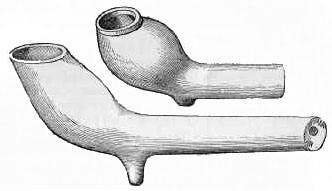Linen and Tobacco
The linen trade had been encouraged, and, indeed, mainly established in Ireland, by the Duke of Ormonde. An English writer [4] says that 200,000 pounds of yarn were sent annually to Manchester, a supply which seemed immense in that age; and yet, in the present day, would hardly keep the hands employed for forty-eight hours. A political economist of the age gives the "unsettledness of the country" as the first of a series of reasons why trade did not flourish in Ireland, and, amongst other remedies, suggests sumptuary laws and a tax upon celibacy, the latter to weigh quite equally on each sex.[5] Sir William Petty does not mention the linen trade, but he does mention the enormous amount of tobacco [6] consumed by the natives. It is still a disputed question whether the so-called "Danes' pipes," of which I give an illustration, were made before the introduction of tobacco by Sir Walter Raleigh, or whether any other narcotizing indigenous plant may have been used. Until one, at least, of these pipes shall have been found in a position which will indicate that they must have been left there at an earlier period than the Elizabethan age, the presumption remains in favour of their modern use.

Danes' Pipes, from the collection of the R.I.A.
Notes
[4] Writer.—Merchant's Map of Commerce: London, 1677.
[5] Sex.—The Interest of Ireland in its Trade and Wealth, by Colonel Lawrence: Dublin, 1682.
[6] Tobacco.—A Table of the Belfast Exports and Imports for the year 1683, has been published in the Ulster Arch. Jour. vol. iii. p. 194, which fully bears out this statement, and is of immense value in determining the general state of Irish commerce at this period. There are, however, some mistakes in the quotations of statistics, probably misprints.
